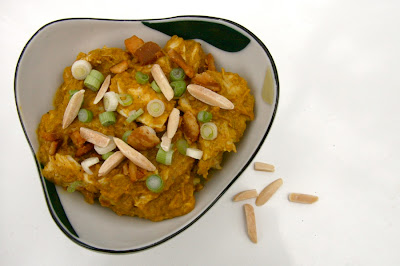
What do you do when you have a surplus of fresh tomatoes? I often make either a quick or a long-simmering tomato sauce. In the summer my default plan is gazpacho. But the last time I had an overstock of tomatoes on my counter, I was in the mood for a different kind of soup. I searched my cookbooks and found a promising candidate - a soup with the herbal flavors of Provence.

n.o.e.'s notes:
- The recipe is from The Splendid Table's How to Eat Supper
- I used fresh tomatoes. The author is very clear that Roma tomatoes are not good to use for anything, and recommends using the best tasting fresh tomatoes available, or good quality canned.
- The recipe's ingredient list specifies dried herbs. It was quite tempting to substitute fresh herbs from my little garden, but I didn't. Boy was I glad when I turned the page and found this note:
"Resist substituting fresh herbs for the dried ones called for here. They should be dried (but never powdered), just as they are in Provence's famous blend, herbes de Provence. The ready-made blend is often stale. Here you will be making your own."- I removed the skins from my fresh tomatoes by immersing in boiling water for 1 minute then immediately putting them into an ice bath. After that the skins just rub off easily.
- I was a bit leery of the cinnamon in the recipe and used less than half and it was almost too much.
- At the end, goat cheese is stirred into the soup. I had a lovely seven-pepper-encrusted goat cheese from the farm box, which added a bit of spicy heat to the soup.
- The recipe has a variation where the dried herbs are replaced by fresh basil, and I plan to try that next time.

the verdict:
This was an unusual take on tomato soup, and I enjoyed every spoonful. The cinnamon nearly ran away with the soup, though, so next time I would add only the smallest pinch, then adjust to taste.
the recipe:
South of France Tomato Soup with Young Chevre
from The Splendid Table's How to Eat Supper
generous 1/2 tsp dried basil
generous 1/2 tsp fennel seeds
generous 1/2 tsp dried oregano
generous 1/2 tsp dried thyme
extra virgin olive oil
3 med onions, finely chopped (I used about 9 ounces)
salt and freshly ground black pepper
3 large garlic cloves, finely chopped
generous 1/4 cup tomato paste
1/3 cup dry vermouth
2 pounds good tasting tomatoes (not Romas), peeled, seeded, and chopped, or one 28-ounce can whole tomatoes with their liquid, crushed
approximately 28 ounces of broth and 2/3 cup water
1/4 tsp ground cinnamon, or to taste (I used 1/8 tsp of Vietnamese cinnamon, and would use less next time)
4 ounces fresh goat cheese, crumbled
1. Combine the dried herbs in a small cup. Crush them lightly until they become fragrant. Set aside.
2. Film the bottom of a 6-quart pot with olive oil. Heat over medium-high heat. Stir in the onions, season with salt and pepper, and cook until the onions are golden brown, 5 to 8 minutes, stirring often. Add the reserved herbs and the garlic. Continue cooking until their aromas open up, about 30 seconds.
3. Blend in the tomato paste until there are no lumps; then add the vermouth and tomatoes. Boil for 2 minutes. Pour in the broth, stir, adjust the heat to a light bubble, and cover the pot tightly. Cook for 20 minutes. Then blend in the cinnamon, and taste the soup for seasoning.
4. Ladle the soup into bowls, and top each serving with crumbles of goat cheese.














